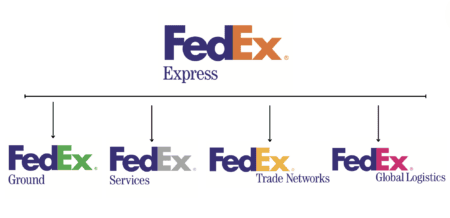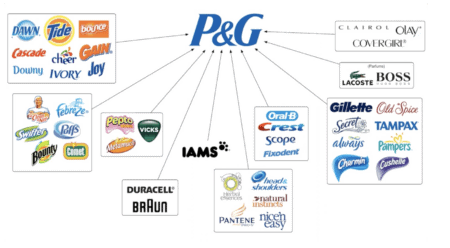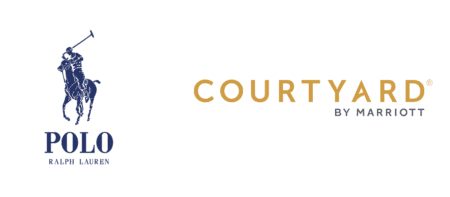Key Takeways:
1. Popular brand architectures include branded houses, houses of brands, and endorser brands.
2. You want a coherent and cohesive brand identity regardless of the naming system you choose.
3. An efficient naming architecture can lay the groundwork for long-term success.

How Solid is your Naming Foundation?

Picture yourself navigating through a maze of houses, each with its own unique style and layout. Some are sleek and modern, while others are a mishmash of different designs accumulated over the years. Just as a poorly planned home can become a chaotic mess, so too can a company’s naming strategy. In the world of branding, where companies evolve through mergers, acquisitions, and organic growth, maintaining coherence in naming can be a challenge. However, with the right approach to naming architecture, businesses can construct a solid foundation for their brand identity, ensuring clarity and consistency in their naming strategies.
The House of Cards Naming Conundrum

In the realm of branding, names can accumulate over time like layers of paint on an old house. Each addition may serve a purpose at the time, but without a cohesive plan, the result can be a disjointed mess. This scenario is what we refer to as the “house of cards” naming conundrum. Companies may find themselves with a plethora of names, each representing a different style or era, leading to confusion among customers and dilution of brand identity.
Naming Architecture as a Solution

Just as a well-designed blueprint guides the construction of a house, a naming architecture provides a structured framework for organizing and managing brand names. It ensures that all names align with the overarching brand strategy, creating a cohesive and harmonious brand ecosystem. By adopting a naming architecture, companies can avoid the pitfalls of haphazard naming and instead cultivate a unified brand identity.
A Branded House

There are several types of naming architectures, each suited to different business needs and objectives. One popular approach is the branded house model, exemplified by companies like FedEx. Under this model, a single master brand is extended to various products or services, using intuitive and descriptive names. This simplifies communication and enables easy expansion into new areas while maintaining brand consistency.
A House of Brands

Another approach is the house of brands model, favored by companies like Procter & Gamble. In this model, each product or service has its own distinct brand name, allowing for targeted marketing and differentiation. While this approach offers flexibility, it requires greater investment in building individual brand identities.
The Endorser Brand

A third strategy is the endorser brand model, where the master brand is subtly endorsed by individual product or service names. This approach, seen in brands like Polo by Ralph Lauren or Courtyard by Marriott, allows for both brand recognition and product differentiation. It safeguards the master brand while providing autonomy to sub-brands.
Crafting the Right Naming System

Choosing the right naming architecture requires careful consideration of factors such as brand goals, target audience, and competitive landscape. It’s not a one-size-fits-all solution but rather a tailored approach that balances creativity with practicality. Companies can leverage tools like AI-driven prompts or seek guidance from professional naming consultants to develop a naming architecture that aligns with their unique needs.
Avoid the House of Cards Trap

In conclusion, a well-defined naming architecture is essential for building a strong and enduring brand identity. It serves as a blueprint for organizing brand names, guiding decision-making, and ensuring consistency across all touchpoints. By avoiding the house of cards naming trap and embracing a structured approach to naming, companies can create a brand ecosystem that resonates with customers and stands the test of time.
Transcription:
Mike Carr (00:02):
So is your naming like a house of cards? And what do I mean by that? So think about you’re in the market for a fixer upper home and you’re going around and you’re taking a look at some of these houses, and you walk into one that’s gone through, let’s say several remodels, and it’s just a disaster. Every room has a different style. Hallways are in weird places. The garage is an obvious, in a weird spot. There’s an extra bedroom that’s sort of been glummed onto the side of the house and the thing’s just a mess. Well, guess what? Naming can become a house of cards too. Through organic growth, through mergers, through acquisitions. You acquire new names or you add names to a growing portfolio, and somebody wants this style of name cool and hip, and somebody else wants a different kind of name. And before you know it, you sort of have this hodgepodge, this house of cards when it comes to naming.
(00:57):
So what’s the solution? Well, a naming architecture, right? Think about a blueprint. If you could build a house from scratch, or if you’re going through a major remodel, you’ll have a blueprint that sort of lays out how all the rooms are going to work. They all flow together, they support one another. The hallways make sense if there’s this underlying structure. Well, that’s sort of what naming architecture can do for your naming. And there are different types of naming architectures, just like there are different types of architectures for homes, different styles. One of the ones that’s been fairly popular, I would say for the last five to 10 years at least, is what’s called the branded house, where you have one master brand. And then underneath that all your names are more intuitive and more descriptive and easier to understand. So they don’t create any confusion.
(01:45):
And an example of that might be FedEx. So you have FedEx Ground, you have FedEx Freight, you have FedEx office. At one point you had FedEx Express. And so it’s pretty easy then to add new services to that naming architecture. So let’s say FedEx wanted to get into the Ocean Liner shipping business, right? These big, huge ships that sail across the ocean, like the one that ran into the bridge in Baltimore. Hopefully not. What would you call that? Maybe FedEx Boat Boat makes a lot of sense. So you’ve got FedEx ground, you’ve got FedEx boat, piece of cake. Everybody gets it until a competitor comes along. And this competitor has got a new kind of ship. It’s a big, huge ship on Hydrofoils, and it flies across the ocean. It zips and man, it can get your freight across the Atlantic or across the Pacific in one third the time that it normally would take a big ship to do it. And they don’t have a generic descriptive name like FedEx Boat. They have a sexy, cool, innovative name that’s
(02:59):
And engaging and just screams speed, like one of my all time favorite names that I talked about in the last podcast too. So now you have FedEx Boat or Streaker. Which name do you think is more engaging? Which name do you think conveys the value prop more directly? So now what do you do? Do you have to go back to the drawing board and change your naming architecture from a brown branded house to a house of brands? Procter and Gamble is an example of a house of brands. So they have very distinct names for each of their products. So they have tie detergent, they have cheer, they have gain, they have bounce. And each name maybe conveys something different about a benefit or the audience, the target they’re going after. Is that the right way to go? And you don’t know and you have to go start all over again.
(03:59):
And so that’s where we can come into play or any professional naming consulting firm is help you lay out a naming architecture that makes sense for you, that gives you the flexibility. So maybe every now and then you need a new brand name, but in other situations you want to go with a more descriptive, intuitive family set of names that don’t require as much of a budget. And those are the types of questions that we wrestle with you is branded names can be really cool and hip and exciting, but unless you have the budget, unless you have the time to build that kind of brand, they can often be a disaster. You have, they’re cool and they’re edgy, but nobody knows what they mean. And that’s the whole reason that these more descriptive and intuitive names often work best unless you’re facing a competitor that’s got that cool hip brand name.
(04:56):
And there are other kinds of naming architectures too. There’s something called the Endorser brand, right? So you think about Polo by Ralph Lauren or Courtyard from Marriott, you’re not putting the brand name in front, you’re putting the brand name after. Why in the world would you want to do that? Why wouldn’t it just be Marriott Courtyard or Ralph Lauren Polo? Well, there are lots of reasons. One reason is you want to protect that master brand. You maybe want the Marriott brand, the Marriott brand, to be associated with perhaps a little more premium experience, a little bit more of that self. Hey, the concierge there, the valets there, they’re taking care of you. Whereas courtyards, more of that do it yourself, maybe a little bit bigger room. You’ve got your kitchen and whatnot. And that’s more for the folks that aren’t interested in all those amenities.
(05:50):
So it might help you launch a new brand like Courtyard or like Polo. But then once that brand’s that by Marriott isn’t nearly as important. And there are other reasons for following the endorser strategy or the house of brand strategy or the branded house strategy. But part of what that naming architecture is going to give you is not just the blueprint, but it’s also the process for how you can name things on your own. It’s going to give you a decision tree. So your internal folks and crews are sort of guided in the right direction that well, you might want that really cool hip name that’s really not going to be best for you. In this particular case, because of the ways you answered these questions, you don’t have the budget, you don’t have the time. The competitive situation is a little bit different. So the right naming architecture might even be a hybrid.
(06:43):
It might allow for endorser brands, it might allow for a master brand over here. It might allow for a few sub-brand names. So the point is, you need to avoid that house of cards, that mishmash mess, especially as you grow. And one of the ways to do that is with the right naming architecture. And of course you can try to do that yourself. And there’s some tools out there through ai. If you were to do a CLA three prompt on naming architectures right for you and go through a series of prompts, you probably get some pretty good ideas. Or you can hire a professional naming firm that maybe has done this for 40 years and has done just about everything wrong. Unfortunately more than once. But now we think we maybe know how to do it right and we’re happy to help you.



